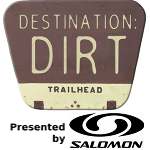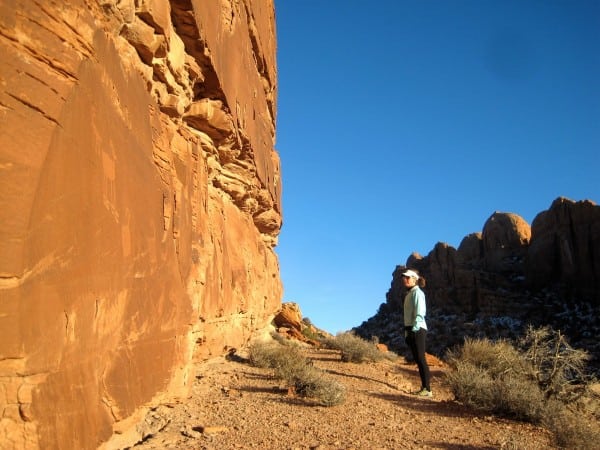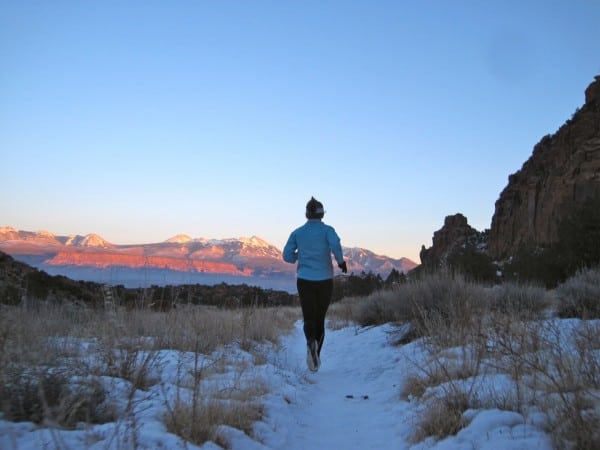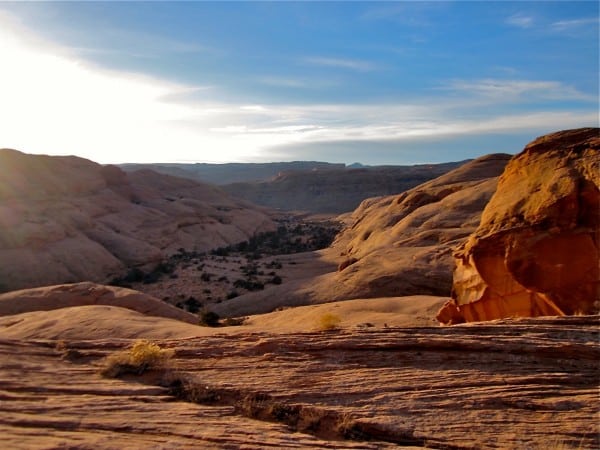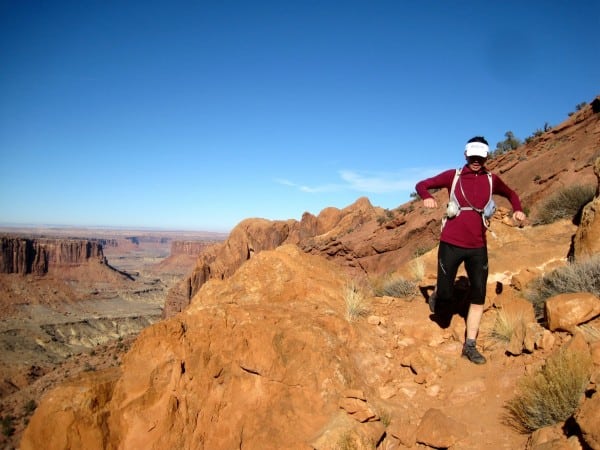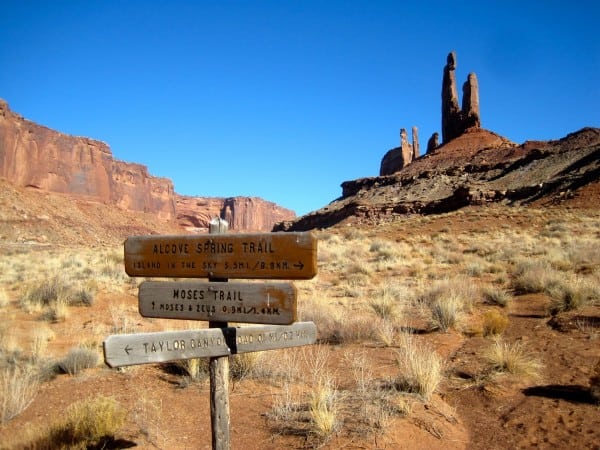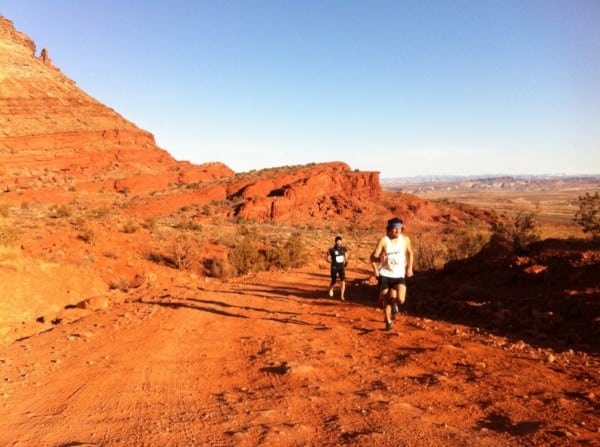Trail running friends, if you haven’t visited and run in Moab, I present this promise: one run and you are done. That is, one run and you will be head-endo-heels obsessed. One run and you’ll take Moab as your trail-running-region mistress. One run and you’ll beg your husband/wife/significant person, “Please, can I pleasepleaseprettyplease have a second home in Moab?”
What is it about this region that’ll catch you hook, line, and leaded sinker? Let me tell you what has enamored me. The blood-orange rocks heaving as fins, spires, and sometimes phallic symbols into unblemished, aquamarine heavens. The feeling of replete, no-one-but-you-and-the-scorpions alone-ness that filters from out of the landscape and into the crooks and corners of you. The sense that the world is freaking enormous – and possibly forever these colors of orange and blue – and you are a miniscule, hardly-seen creature.
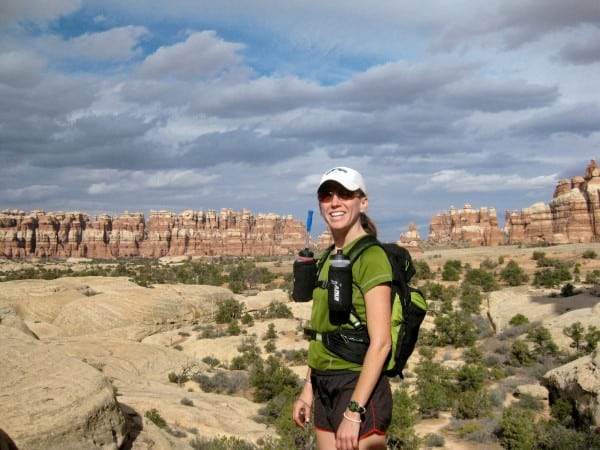
The author taking a break during a trail run through Canyonlands National Park’s Needles District. Photo: Bryon Powell
Located where the Colorado River curves out of, well, Colorado and carves into the red sandstone of eastern Utah, Moab is year-round home to 5,000-ish residents and a tourist destination for a few million visitors. Bureau of Land Management, National Park Service, and other public lands begin at the literal edge of town and extend in every direction for dozens to hundreds of miles. Moab has been on the recreational radars of jeep-ers and mountain bikers since the near-dawn of those technological inventions. Though long a local’s secret, trail running on the region’s singletrack, doubletrack, and slickrock has only recently captured the attention of our community.
The Moab region is mostly warm, arid, and sometimes prickly. Take care of the following obstacles when running there:
- Heat and aridity – May through September see daily highs in the 90s and sometimes 100s Fahrenheit. On every warm-weather excursion, bring with you more water than you think you’ll need.
- Cold, aridity, and frozen trails – Wintertime trail running in Moab is sweet stuff, but you’ll find the same aridity of summer as well as cold temperatures. Layer up and carry a lot of water as you’ll be be surprised how dry the air always is. Finally, beware the snow and ice that lingers on trails after recent precipitation events. Last winter, I slipped and fell hard, really hard, on a shaded section of slickrock still covered with ice from a storm a couple days before I arrived. The ice was super-thin and the color of the rock around it, that is to say indetectable, except to my sore tailbone afterward.
- Cacti and other things with thorns and spikes – Just avoid them. It’s as simple as that.
- Predators – Mountain lions call the Moab region home. Though rarely seen, they are higher on the food chain than you. Consider running with company, especially if you plan to run at night or twilight.
- Scorpions, snakes, and spiders – Stuff stings and bites in Moab. Watch where you put your feet and hands. If you take off your shoes for a while, especially if you’re camping and you leave them outside the tent for the night, give them a good shake before putting them back on.
- Getting lost – For the sake of yourself, search-and-rescue professionals, and our general trail-running culture, don’t get lost. It’s tempting to run amok when you encounter a place as cool as Moab, but, as they say in places that are not the desert, get yourself in only as deep as you have skills to swim. Always carry a map and, in some cases, a compass. Know how to read/use both. Tell people where you are going and when you’ll be back. And more safety may be found in numbers, so consider running in a group.
Below, we’ll provide you with examples of easy, moderate, and advanced trail runs in and near Moab. After giving you some example runs, we’ll let you know where to hunt down last-minute gear and food. We’ll also provide a resources list, where you can learn more about the experiences you’re about to have.
[Ps. If you like the photos in this article, check out iRunFar’s Facebook album for a single weekend in and around Moab in January 2012.]
Easy Trail Run – Hidden Valley Trail
To access the trail, drive three miles south of downtown Moab on Highway 191, turn right on Angel Rock Road, then another right onto Rimrock Road, which leads to the trailhead parking lot. The trail immediately climbs about 500 vertical feet on a series of short switchbacks to the southern end of Hidden Valley. From there, run singletrack to the north end of Hidden Valley and a small pass. Views of the Behind the Rocks area and its rust-colored sandstone spires from this wee pass are killer. Deviate to the right of the trail, following a small, social path to a wall of sandstone heavily decorated with petroglyphs. Remember to look and don’t touch; these markers of human history are federally protected.
If you return the way you came, it’s a three-mile roundtrip voyage. For a one-way, car-shuttle-required, six-ish mile alternate, head back to the Hidden Valley Trail, duck west off the pass, and connect with the Moab Rim Trail. This 4×4 doubletrack is used more by mountain bikers than engine-d devices, and it ends roughly 4.5 miles later at a trailhead along the Kane Creek Road, a few miles west of Moab and about 1,200 vertical feet lower than the rock art.
Insider’s Scoop: Heading toward the Kane Creek Trailhead on the Moab Rim Trail along the one-way route, about a 3/4 mile after the rock art, take the right-hand spur and climb a 1/2 mile up to a Moab-and-everything-eastward overlook. Return to the Moab Rim Trail. Also, Hidden Valley sits in the shadows a lot, which makes it cold enough for tights and gloves by winter and cool enough to provide respite from the heat of summer.
Moderate Trail Run – Poison Spider Mesa and Golden Spike Trails
Access these jeep-crawler routes from six miles west of Moab on Highway 279, also called the Potash Road. Turn right on the Poison Spider Mesa Trail and drive up a short distance to a parking lot. In the first 2.5 miles, you’ll climb 800 or so feet up mostly slickrock to the top of Poison Spider Mesa. As you climb, keep your eyes peeled for sweet views of the Colorado River below as well as orange sandstone that extends as a slickrock sea. Continue across the mesa top, where the trail is mostly dirt, until you dip down to the intersection with the Golden Spike Trail at mile five. It’s a confusing intersection, so you’ll need a map. Head out the Golden Spike Trail as far as you like before turning around to return the way you came.
This slickrock route is used by jeeps and dirt bikes, so watch out for these beasts of burden. If you do encounter a jeep negotiating the gnarliest slickrock sections, it’s worth it to stop and watch. All ethical dilemmas about vehicles in the backcountry aside, we’re talking about some of the best technical driving skills you’ll ever see. Ever.
Insider’s Scoop: If you’ve got it in you to turn this into a long run, make your turnaround the overlook located 5.1 miles from the Poison Spider Mesa/Golden Spike Trail intersection along the Golden Spike Trail. This 20.2-miler involves time spent at the sickest, sickest, sickest of slickrock overlooks. We’re talking poop-your-pants, use-all-of-your-memory-card pretty.
Advanced Trail Run – Islands in the Sky Loop in Canyonlands National Park
Drive to the Upheaval Dome Trailhead in Canyonlands National Park’s Islands in the Sky District, about a 90-minute drive from town. Take the Syncline Trail around the south side of Upheaval Dome, using care to follow the cairns through the areas of slickrock. Along this section, you’ll, at times, have long views that reach as far as the Green River about 20 miles west, with hundreds of layers of sandstone between you and it. At about 3.5 miles in, the Syncline Trail is intersected by the Upheaval Canyon Trail in a dry wash with a sign.
Go left and proceed another 3.5 miles down the Upheaval Canyon Trail which pretty much follows the dry wash all the way to the famous White Rim Road. Go right for a 1/2 mile on the White Rim Road, a 4×4 road used by jeeps and mountain bikes, to the intersection with the rarely driven Taylor Canyon Road. Turn right and begin the five-mile gentle climb up Taylor Canyon Road to the end of the road and the Alcove Springs Trailhead. You’ll have some huge rock spires called Moses and Zeus to inspire your running here.
Run 5.6 miles back to pavement on the Alcove Springs Trail. At first, the trail climbs gently through a sandy dry wash, so use care to follow the cairns. Later, the trail makes a spidery climb past a gorgeous natural and enormous rock alcove. Once you arrive to pavement, turn right and run 1.5-ish miles back to your car at the Upheaval Canyon Trailhead.
Insider’s Scoop: Backcountry navigation skills and a map are critical for success on this loop, as there are many places in which the trail will not seem like a trail. You’re likely to see no one out here – and you won’t have cell service either – so be prepared for 100% self-sufficiency. As is, this loop is just shy of 20 miles. For a fun bonus, take the spur trail to Moses and Zeus. You’ll add on two miles roundtrip, but you’ll also score some great face time with these quirky erosional features.
Get Gear:
There’s a City Market grocery store in Moab with whatever fixins’ you’ll need for a picnic in the park or eats on the trail. They’ve got a great section of bars, gels, and gooey-chewy-blok items.
There’s a slew of gear purveyors in Moab, so many that you could seriously show up bag-less, shoe-less, and nekkie and you’d be geared up and ready to hit the trail in no time.
Mountain biking is sickly popular in Moab, so it’s simple to rent a high-end, full-suspension bike from any of the half-dozen or so rental shops in town if you seek a little cross training.
Finally, if the jeep-crawling thing is up your alley, take a tour and get driven around the slickrock by the experts. Again, there are about a half-dozen jeep-tour operators in Moab.
Good Eats:
The Moab Brewery dishes up good post-run eats if you’re into burgers for dinner and gelato for dessert. They are best known for their nine brews made in-house, plus whatever is seasonally brewing. By winter, I prefer the Black Raven Oatmeal Stout with its choco-aftertaste and its perfect lack of head. By summer, I’m tempted to the Golden Sprocket Wit Ale, because I can taste its coriander and orange.
Eklecticafe serves brekkie and lunch like no one’s bizz. Breakfast burritos, huevos rancheros, quiches, potato skillets, and more, all made with organic ingredients and vegan, if you ask. Consider going splitsies on a main dish – they are dang big – so that you have room for their house-made desserts. There are no words for the delight that is their cheesecakes, meringues, and more. Bonus, the cafe sells some of the small, artsy wares of locals and some antiques, so don’t be surprised if you leave with more than a full belly.
Eddie McStiff’s is another highly popular joint, as evidenced by their full parking lot on weekend nights. They do super happy-hour deals, certain pints and some sort of tasty food at ridiculously inexpensive prices. They also brew their own beer, but last time I drank there in March of 2012, it was a short selection of all wheat beers. I drank the raspberry wheat, and put away two pints! Dinner here won’t disappoint. Our hands-down fave menu items are the Baja-style fish tacos and the vegetarian, falafel-based Falacos.
Finally, you’ll love the breakfast and lunch food at the Love Muffin Cafe, too. Did someone say waffles? Giant, soft-inside-crisp-outside waffles! (They can make vegan waffles, if you like.) If you like chai, order up theirs, which is a homemade blend.
Additional Resources:
Arches National Park is out Moab’s northern door, and a Moab visit must include a perusal of this park. Canyonlands National Park is a bit further afield to the west and south of town. Peekaboo Canyonlands’ website.
The Bureau of Land Management Moab Field Office administers much of the land surrounding Moab. Get edu-ma-cated here. Start with this website if you wish to know about the free or cheap and legal camping opportunities near town.

Camp during a fastpack through Canyonlands’ Needles District. [Bonus: This trail was the basis of the author’s story on fastpacking in Trail Runner magazine! Photo: Bryon Powell
Call for Comments
Do you have a fantastic story on trail running in the Moab region? Have you blogged your own trip report, especially with some delicious scenery photos? Did we miss something or make an error? Let us and everyone else know in the comments section.
